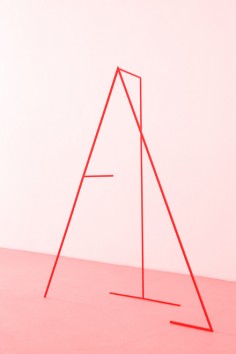THEA DJORDJADZE

source: listartmitedu
Combining traditional materials of sculpture such as plaster and wood with everyday objects like foam and linoleum, Thea Djordjadze (born 1971, Tbilisi, Georgia) creates installations of sculptural objects that are sited to respond to one another and the space of their installation. Her work is characterized by tensions between materials and forms. Geometric constructions drawn from modernist architecture and design are exhibited together with clay sculptures and carpets that reveal their status as handmade. Her use of linoleum—an inexpensive floor covering widely used for kitchen floors in the early 20th century—further brings a sense of domesticity to the museum. Djordjadze’s work often gestures towards exhibition furniture, including plinths and vitrines, while simultaneously upending the conventions of museum display, such as when a foam slab approximating the dimensions of a mattress is displayed on its side supported by a thin steel structure.
About the Artist
Thea Djordjadze (born 1971, Tbilisi, Georgia) studied under Rosemarie Trockel at the Kunstakademie Düsseldorf and currently lives and works in Berlin. Her recent exhibitions include the Georgian Pavilion at the 2013 Venice Biennale; Kölnischer Kunstverein, Germany; Malmö Konsthall, Sweden; Kunsthalle Basel, Switzerland; and a major solo installation at Documenta 13 in Kassel, Germany. Selected group exhibitions include the 2003 Venice Biennale; the 5th Berlin Biennial for Contemporary Art in 2008; Centre Georges Pompidou, Paris; Hayward Gallery, London; and Contemporary Art Museum St. Louis.
Thea Djordjadze is curated by Paul C. Ha, Director, and Alise Upitis, Assistant Curator, MIT List Visual Arts Center
Support for this exhibition has been generously provided by Julian & Barbara Cherubini, Embassy of Georgia to the U.S., the Council for the Arts at MIT, the Office of the Associate Provost at MIT, the Massachusetts Cultural Council, the MIT List Visual Arts Center Advisory Committee, and the Friends of the List. Special thanks to Sprüth Magers Berlin London.
.
.
.
.
.
.
.
source: theguardian
It’s rare that art as apparently spartan as Thea Djordjadze’s can be so tantalising. The thin wooden or metal frames and glass vitrines that frequently star in her sculptural assemblages suggest a minimalist sensibility and evoke the pristine, poker-faced displays of museums. Yet these elements of her art rub shoulders with more worn-in, personal fare, including rugs, reconfigured furniture and rough, hand-moulded lumps of uncooked clay. Things look fragile and faded, like relics from a lost civilisation.
Djordjadze’s materials are worked fast and arranged intuitively, with an eye for colour, texture and lines drawn through space that hints at her early training as a painter. Growing up in former communist Georgia has also left its mark on the Berlin-based artist’s sensibility. Her work often features the country’s local carpets, while its pared-back appearance and flimsy materials echo the clean, definite forms of eastern-bloc architecture, belying a shaky political regime. In place of modernist purity, she creates poetic, allusive arrangements of objects, hinting at stories that never sit still.
As sagas sa, her contribution to the current Documenta (13), uses the perfect setting for her sculptural micro-universe: a cavernous greenhouse emptied of plant life, with a gravelly dry-dirt floor and stained panes. It’s like a cross between some millennia-old museum’s vitrine and a wasted version of the vegetation-filled glass domes travelling through space, in the 1970s sci-fi classic Silent Running.
Wandering through the installation she’s created in response to the site, you’re in a self-contained world. Tableaux of furniture, glass cases and paint-smeared blocks of foam suggest the enclosed realms of both domestic life and theatrical display. A faded, cheap, gauzy fabric hangs across one end of the arid greenhouse like a stage curtain, or a waterfall.
All these objects soon start to shapeshift in your head. A sharp rectangle and square become a neatly geometric bed and pillow. Yet for all its minimalist precision, the piece is made of squidgy, vulnerable foam and smeared with gooey white pigment. It’s unnervingly physical, begrimed, sexual. The plastic chair sitting at its foot might be a nurse at a sickbed, or the aggressive master to this passive, prone form.
.
.
.
.
.
.
.
source: d13documentade
Thea Djordjadze wurde 1971 in Tiflis geboren und lebt in Berlin. Sie hatte Einzelausstellungen im Malmö Konstmuseum (2012), in der Kunsthalle Basel (2009), im Kunstverein Nürnberg (2009), Studio Voltaire, London (2007), und im Bonner Kunstverein (2001). Djordjadze war Teilnehmerin der Berlin Biennale (2008), der Biennale de Lyon (2007) und der Biennale di Venezia (2003).

